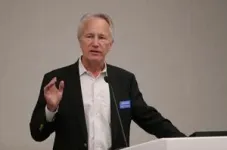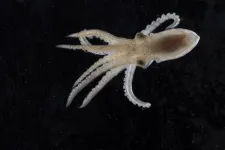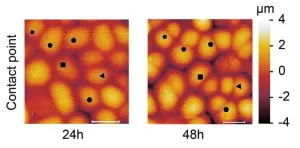(Press-News.org) Researchers led by Giulia Galli at University of Chicago’s Pritzker School of Molecular Engineering report a computational study that predicts the conditions to create specific spin defects in silicon carbide. Their findings, published online in Nature Communications, represent an important step towards identifying fabrication parameters for spin defects useful for quantum technologies.
Electronic spin defects in semiconductors and insulators are rich platforms for quantum information, sensing, and communication applications. Defects are impurities and/or misplaced atoms in a solid and the electrons associated with these atomic defects carry a spin. This quantum mechanical property can be used to provide a controllable qubit, the basic unit of operation in quantum technologies.
Yet the synthesis of these spin defects, typically achieved experimentally by implantation and annealing processes, is not yet well understood and, importantly, cannot yet be fully optimized. In silicon carbide — an attractive host material for spin qubits due to its industrial availability — different experiments have so far yielded different recommendations and outcomes for creating the desired spin defects.
“There hasn’t yet been a clear strategy to engineer the formation of spin defects to the exact specifications we want, a capability that would be highly advantageous for advancing quantum technologies,” says Galli, the Liew Family Professor of Molecular Engineering and Chemistry, who is the corresponding author of the new paper. “So, we embarked in a long computational journey to ask the following question: Can we understand how these defects form by carrying out comprehensive atomistic simulations?”
Galli’s team—including Cunzhi Zhang, a postdoctoral researcher in Galli’s group, and Francois Gygi, a professor of computer science at the University of California, Davis—have combined multiple computational techniques and algorithms to predict the formation of specific spin defects in silicon carbide known as “divacancies”.
“Divacancies are created by removing a silicon and a carbon atom sitting close together in a silicon carbide solid. We know from previous experiments that these types of defects are promising platforms for sensing applications”, Zhang says.
Quantum sensing could enable detection of magnetic and electric fields and also reveal how complex chemical reactions occur, beyond what’s possible with today’s technologies. “To unlock quantum sensing capabilities in the solid-state, we first need to be able to create the right spin defects or qubits at the right location.” Galli says.
To find a recipe for predicting the formation of particular spin defects, Galli and her team combined several techniques to help them look at the movements of atoms and charges when a defect forms as a function of temperature.
“Typically, when a spin defect is created, other defects also appear and those may negatively interfere with the targeted sensing capabilities of the spin defect,” says Gygi, the main developer of the first-principles molecular dynamics code Qbox used in the team’s quantum simulations. “Being able to fully understand the complex mechanism of defect formation is very important.”
The team coupled the Qbox code with other advanced sampling techniques developed within the Midwest Integrated Center for Computational Materials (MICCoM), a computational materials science center headquartered at Argonne National Laboratory and funded by the Department of Energy, of which both Galli and Gygi are senior investigators.
“Our combined techniques and multiple simulations revealed to us the specific conditions under which divacancy spin defects can be efficiently and controllably formed in silicon carbide,” Galli says. “In our calculations, we are letting the fundamental physics equations tell us what is happening inside the crystal structure when defects form.”
The team expects that experimentalists will be interested in using their computational tools to engineer a variety of spin defects in silicon carbide and also other semiconductors, yet cautions that generalizing their tool to predict a broader range of defect formation processes and defect arrays will require more work. “But the proof of principle we have provided is important—we showed that we can computationally determine some of the conditions required to create the desired spin defects” Galli says.
Next, her team will continue working to expand their computational studies and speed up their algorithms. They also would like to expand their investigation to include a range of more realistic conditions. “Here, we’re only looking at samples in their bulk form, but in experimental samples there are surfaces, strain, and also macroscopic defects. We would like to include their presence in our future simulations and in particular understand how surfaces influence spin defect formation,” Galli says.
Although her team’s advance is based on computational studies, Galli says all their predictions are rooted in long-standing collaborations with experimentalists. “Without the ecosystem we work in, constantly talking with and partnering with experimentalists, this wouldn’t have happened.”
The work is funded by the Department of Energy through the MICCoM ( https://miccom-center.uchicago.edu/) and Q-NEXT (https://q-next.org/) centers.
END
Simulations reveal the atomic-scale story of qubits
By using sophisticated computer simulations at the atomic scale, a new study predicts the formation process of spin defects useful for quantum technologies
2023-10-02
ELSE PRESS RELEASES FROM THIS DATE:
Fair and sustainable futures beyond mining
2023-10-02
Mining brings huge social and environmental change to communities: landscapes, livelihoods and the social fabric evolve alongside the industry. But what happens when the mines close? What problems face communities that lose their main employer and the very core of their identity and social networks? A research fellow at the University of Göttingen provides recommendations for governments to successfully navigate mining communities through their transition toward non-mining economies. Based on past experiences with industrial transitions, she suggests that a three-step approach centred around stakeholder ...
Losing sleep? It might be time to check your blood pressure
2023-10-02
New study from Brigham researchers highlights a correlation between symptoms of insomnia and hypertension in women
Getting enough sleep has never been more difficult in today's fast-paced environment. Yet new research from investigators in the Channing Division of Network Medicine of Brigham and Women’s Hospital, a founding member of the Mass General Brigham healthcare system, highlights why getting a good night’s sleep is critical to staying healthy. Their research unveils that women who struggled with getting enough sleep were at greater risk of ...
Recent advances in oral health and tooth research
2023-10-02
With Halloween just around the corner, many people are pulling out plastic fangs or gnarly fake teeth to finish off their outfits. But costume prosthetics don’t replace good oral hygiene or treatments to align teeth. Below are some recent papers published in ACS journals that report insights from ancient teeth and improvements to modern dental practices. Reporters can request free access to these papers by emailing newsroom@acs.org
“Extraction Protocol for Parallel Analysis of Proteins and DNA from Ancient Teeth and Dental Calculus”
Journal of Proteome Research
Sept.12, ...
Study uncovers function of mysterious disordered regions of proteins implicated in cancer
2023-10-02
Study uncovers function of mysterious disordered regions of proteins implicated in cancer
Study Title: A disordered region controls cBAF activity via condensation and partner recruitment
Publication: Cell, Monday, October 2, 2023 (https://www.dana-farber.org/newsroom/news-releases/2023/study-uncovers-function-of-mysterious-disordered-regions-of-proteins-implicated-in-cancer/)
Dana-Farber Cancer Institute author: Cigall Kadoch, PhD
Summary:
New research from Dana-Farber Cancer Institute researcher Cigall Kadoch, PhD, along with colleagues at Princeton University and the Washington University in St. Louis, reveals a key role for intrinsically disordered ...
Liquid biopsy may help identify which patients with non-small cell lung cancer will benefit most from radiation
2023-10-02
SAN DIEGO, October 2, 2023 — A novel liquid biopsy test may help determine which patients with non-small cell lung cancer that has spread beyond the lungs are most likely to benefit from targeted, high-dose radiation, rather than drug-based therapy, a new study suggests. Findings will be presented today at the American Society for Radiation Oncology (ASTRO) Annual Meeting and published in npj Precision Oncology.
The study found that a liquid biopsy test – which identifies tumor DNA circulating ...
Pumped for frigid weather: study pinpoints cold adaptations in nervous system of Antarctic octopus
2023-10-02
By Wynne Parry
Laden with dissolved salt, Antarctic waters can hover just above freezing and even dip below it. Temperatures this low would likely kill the animals that prosper in warmer waters further north. Yet, some creatures have found ways to live in this inhospitable cold.
In a new study described in Proceedings of the National Academy of Sciences, researchers at the Marine Biological Laboratory (MBL) and their collaborators focused on how life in such a frigid habitat has altered an enzyme essential ...
Scientists identify evolutionary gateway helping pneumonia bacteria become resistant to antibiotics
2023-10-02
**Strictly embargoed until 20:00 (BST) Monday 2 October 2023**
Scientists identify evolutionary gateway helping pneumonia bacteria become resistant to antibiotics
A new study from the University of Sheffield has revealed how pneumonia cells start to become resistant to penicillin antibiotics
The effectiveness of antibiotics is increasingly under threat as the bacteria which cause pneumonia become more resistant to antibiotic treatment over time
The new research is a major step forward in helping scientists to better predict which ...
How new plant cell walls change their mechanical properties after cell division
2023-10-02
Scientists reveal new plant cell walls can have significantly different mechanical properties compared to surrounding parental cell walls, enabling cells to change their local shape and influence the growth of plant organs.
This is the first time that scientists have related mechanics to cell wall “age” and was only made possible through a new method that follows the same cells over time and through successive rounds of division.
The Cambridge researchers were able to see new walls forming and then measure their mechanical properties. This pioneering work showed that new cell walls in some plants are 1.5 times stiffer than the surrounding ...
Study shows how ‘superbacteria’ were prevented from spreading in a large tertiary hospital
2023-10-02
Rapid identification of patients contaminated by “superbacteria” known as “carbapenem-resistant Enterobacteriaceae” (CRE), with early isolation of these patients, reduces transmission in hospital emergency departments. However, keeping them in the emergency room (ER) for more than two days undermines containment because it increases the risk of infection via colonization.
These are the key findings of a study by a group at the University of São Paulo’s Medical School (FM-USP) in Brazil. An article on the study is published in the journal Clinical Infectious Diseases.
Enterobacteria ...
MDMA increases feelings of connection during conversation, showing promise for therapy
2023-10-02
MDMA, commonly known as ecstasy, is a recreational psychedelic drug often used at parties and dance clubs because it creates feelings of closeness and social connection with others. Because of this “empathogenic” effect, researchers are also interested in its potential use as a complement to traditional talk therapy. In fact, two recent successful clinical trials support the use of MDMA-assisted therapy as a treatment for post-traumatic stress disorder (PTSD).
Researchers at the University of Chicago published a study in Scientific Reports on September 22, 2023, that looked more closely at the pharmacological ...
LAST 30 PRESS RELEASES:
Researchers find promising new way to boost the immune response to cancer
Coffee as a staining agent substitute in electron microscopy
Revealing the diversity of olfactory receptors in hagfish and its implications for early vertebrate evolution
Development of an ultrasonic sensor capable of cuffless, non-invasive blood pressure measurement
Longer treatment with medications for opioid use disorder is associated with greater probability of survival
Strategy over morality can help conservation campaigns reduce ivory demand, research shows
Rising temperatures reshape microbial carbon cycling during animal carcass decomposition in water
Achieving ultra-low-power explosive jumps via locust bio-hybrid muscle actuators
Plant-derived phenolic acids revive the power of tetracycline against drug-resistant bacteria
Cooperation: A costly affair in bacterial social behaviour?
Viruses in wastewater: Silent drivers of pollution removal and antibiotic resistance
Sub-iethal water disinfection may accelerate the spread of antibiotic resistance
Three in four new Australian moms struggle with body image
Post-stroke injection protects the brain in preclinical study
Cardiovascular risk score predicts multiple eye diseases
Health: estimated one in ten British adults used or interested in GLP-1 medications for weight loss
Exercise to treat depression yields similar results to therapy
Whooping cough vaccination for pregnant women strengthens babies’ immune system
Dramatic decline in new cases of orphanhood in Uganda driven by HIV treatment and prevention programs
Stopping weight loss drugs linked to weight regain and reversal of heart health markers
Higher intake of food preservatives linked to increased cancer risk
Mass General Brigham–developed cholera vaccine completes phase 1 trial
First experimental validation of a “150-year-old chemical common sense” direct visualization of the molecular structural changes in the ultrafast anthracene [4+4] photocycloaddition reaction
Lack of support for people on weight loss drugs leaves them vulnerable to nutritional deficiencies, say experts
Dogs’ dinners can have greater climate impact than owners’
Are you ready to swap salmon for sprats and sardines?
1.6 million UK adults used weight loss drugs in past year
American College of Cardiology comments on new dietary guidelines for Americans
American Society of Gene & Cell Therapy and Orphan Therapeutics Accelerator partner to advance and commercialize promising rare disease treatments
One in 14 patients having day case surgery have new or worse chronic pain 3 months after their operation
[Press-News.org] Simulations reveal the atomic-scale story of qubitsBy using sophisticated computer simulations at the atomic scale, a new study predicts the formation process of spin defects useful for quantum technologies






